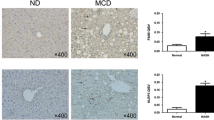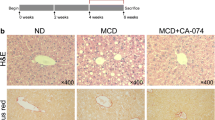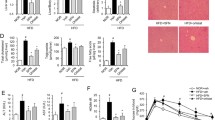Abstract
Objective
To investigate the effect of curcumol on NOD-like receptor thermoprotein domain 3 (NLRP3) inflammasomes, and analyze the mechanism underlying curcumol against liver fibrosis.
Methods
Thirty Kunming mice were divided into a control group, a model group and a curcumol group according to a random number table, 10 mice in each group. Mice were intraperitoneally injected with 40% carbon tetrachloride (CCl4:peanut oil, 2:3 preparation) at 5 mL/kg for 6 weeks, twice a week, for developing a liver fibrosis model. The mice in the control group were given the same amount of peanut oil twice a week for 6 weeks. The mice in the curcumol group were given curcumol (30 mL/kg) intragastrically, and the mice in the model and control groups were given the same amount of normal saline once a day for 6 weeks. Changes in liver structure were observed by hematoxylin and eosin (HE) and Masson staining. Liver function, liver fiber indices, and the expression of interleukin (IL)-10 and tumor necrosis factor-α (TNF-α) levels were determined by automatic biochemical analyzer and enzyme linked immunosorbent assay kit. Immunoblotting and reverse transcription-quantitative PCR (RT-qPCR) were performed to detect the expression of NLRP3 inflammasome-related molecules, TGF-β and collagen.
Results
HE and Masson staining results showed that the hepatocytes of the model group were arranged irregularly with pseudo-lobular structure and a large amount of collagen deposition. The mice in the curcumol group had a significant decrease in liver function and liver fibers indices compared with the model group (P<0.05); RT-qPCR and Western blotting results reveal that, in the curcumol group, the mRNA and protein expression levels of NLRP3, IL-1 β, Caspase 1 and gasdermin D decreased significantly compared with the model group (P<0.05); immunohistochemical results showed that in the curcumol group, the protein expression levels of NLRP3 and IL-1 β decreased significantly compared with the model group (P<0.05).
Conclusion
A potential anti-liver fibrosis mechanism of curcumol may be associated with the inhibition of NLRP3 inflammasomes and decreasing the downstream inflammatory response.
Similar content being viewed by others
References
Tacke F, Trautwein C. Mechanisms of liver fibrosis resolution. J Hepatol 2015;63:1038–1039.
Ellis EL, Mann DA. Clinical evidence for the regression of liver fibrosis. J Hepatol 2012;56:1171–1180.
Wree A, Eguchi A, McGeough MD, Pena CA, Johnson CD, Canbay A, et al. NLRP3 inflammasome activation results in hepatocyte pyroptosis, liver inflammation, and fibrosis in mice. Hepatology 2014;59:898–910.
Gross O, Thomas CJ, Guarda G, Tschopp J. The inflammasome: an integrated view. Immunol Rev 2011;243:136–151.
Szabo G, Csak T. Inflammasomes in liver diseases. J Hepatol 2012;57:642–654.
Meng N, Xia M, Lu YQ, Wang M, Boini KM, Li PL, et al. Activation of NLRP3 inflammasomes in mouse hepatic stellate cells during Schistosoma J. infection. Oncotarget 2016;7:39316–39331.
Kayagaki N, Stowe IB, Lee BL, O’Rourke K, Anderson K, Warming S, et al. Caspase-11 cleaves gasdermin D for non-canonical inflammasome signalling. Nature 2015;526:666–671.
Zheng Y, Wang JH, Liang TJ, Wang L, Zhao TJ. Effect of curcumol on Rho-ROCK signaling pathway in hepatic stellate cells. Chin Hosp Pharm J (Chin) 2019;39:1517–1520.
Xu JM, Xu SY, Zhang YF. Establishment of a mouse liver fibrosis model induced by carbon tetrachloride. Chin Pharm Bull (Chin) 2000;16:339–341.
Zheng Y, Wang JR, Liu LL, Wang JH, Zhao TJ. Molecular mechanism of the anti-liver fibrosis effect of curcumol: an analysis based on the TLR4/NF-κB signaling pathway. J Clin Hepatol (Chin) 2020;36:1508–1513.
Bataller R, Brenner DA. Liver fibrosis. J Clin Invest 2005;115:209–218.
Poilil Surendran S, George Thomas R, Moon MJ, Jeong YY. Nanoparticles for the treatment of liver fibrosis. Int J Nanomed 2017;12:6997–7006.
Mona H, Ismail MP. Reversal of liver fibrosis. Saudi J Gastroenterol 2009;15:72–79.
Ouyang X, Ghani A, Mehal WZ. Inflammasome biology in fibrogenesis. Biochim Biophys Acta 2013;1832:979–988.
Watanabe A, Sohail MA, Gomes DA, Hashmi A, Nagata J, Sutterwala FS, et al. Inflammasome-mediated regulation of hepatic stellate cells. Am J Physiol Gastrointest Liver Physiol 2009;296:G1248–G1257.
Krenkel O, Tacke F. Liver macrophages in tissue homeostasis and disease. Nat Rev Immunol 2017;17:306–321.
Awad F, Assrawi E, Jumeau C, Georgin-Lavialle S, Cobret L, Duquesnoy P, et al. Impact of human monocyte and macrophage polarization on NLR expression and NLRP3 inflammasome activation. PLoS One 2017;12:e0175336.
Weiskirchen R, Tacke F. Cellular and molecular functions of hepatic stellate cells in inflammatory responses and liver immunology. Hepatobiliary Surg Nutr 2014;3:344–363.
Gieling RG, Wallace K, Han YP. Interleukin-1 participates in the progression from liver injury to fibrosis. Am J Physiol Gastrointest Liver Physiol 2009;296:G1324–G1331.
Kamari Y, Shaish A, Vax E, Shemesh S, Kandel-Kfir M, Arbel Y, et al. Lack of interleukin-1alpha or interleukin-1beta inhibits transformation of steatosis to steatohepatitis and liver fibrosis in hypercholesterolemic mice. J Hepatol 2011;55:1086–1094.
Snouwaert JN, Nguyen M, Repenning PW, Dye R, Livingston EW, Kovarova M, et al. An NLRP3 mutation causes arthropathy and osteoporosis in humanized mice. Cell Rep 2016;17:3077–3088.
Robert S, Gicquel T, Victoni T, Valença S, Barreto E, Bailly-Maître B, et al. Involvement of matrix metalloproteinases (MMPs) and inflammasome pathway in molecular mechanisms of fibrosis. Biosci Rep 2016;36:e00360.
Dong HY, Li Y, Zhao GM. Comparative observation of serum liver fibrosis indexes and liver pathology. Intern J Epidemiol Infect Dis (Chin) 2006;2:81–82.
Li Q, Ou XJ, Li J, Jia JD, Wang BE. A comparative study of serum liver fibrosis indexes and liver pathology. J Clin Hepatol (Chin) 2004;3:155–156.
Kew MC. Serum aminotransferase concentration as evidence of hepatocellular damage. Lancet 2000;355:591–592.
Chen CJ, Yang HI, Su J. Risk of hepatocellular carcinoma across a biological gradient of serum hepatitis B virus DNA level. JAMA 2006;295:65–73.
Iloeje UH, Yang HI, Su J. Predicting cirrhosis risk based on the level of circulating hepatitis B viral load. Gastroenterology 2006;130:678–686.
Peiro C, Lorenzo O, Carraro R, Sanchez-Ferrer CF. IL-1 β inhibition in cardiovascular complications associated to diabetes mellitus. Front Pharmacol 2017;8:363.
Altamirano-Barrera A, Barranco-Fragoso B, Méndez-Sánchez N. Management strategies for liver fibrosis. Ann Hepatol 2017;16:48–56.
Liu X, Zhang Z, Ruan J, Pan Y, Magupalli VG, Wu H, et al. Inflammasome-activated gasdermin D causes pyroptosis by forming membrane pores. Nature 2016;535:153–158.
Liu Y, Zhang T, Zhou Y, Li J, Liang X, Zhou N, et al. Visualization of perforin/gasdermin/complement-formed pores in real cell membranes using atomic force microscopy. Cell Mol Immunol 2019;16:611–620.
Sagoo P, Garcia Z, Breart B, Lemaitre F, Michonneau D, Albert ML, et al. In vivo imaging of inflammasome activation reveals a subcapsular macrophage burst response that mobilizes innate and adaptive immunity. Nat Med 2016;22:64–71.
Karki R, Kanneganti TD. Diverging inflammasome signals in tumorigenesis and potential targeting. Nat Rev Cancer 2019;19:197–214.
Acknowledgements
The authors would like to thank Guangxi University of Chinese Medicine for providing the laboratory equipment and technological support.
Author information
Authors and Affiliations
Contributions
Zheng Y and Zhao TJ designed this experiment. Zheng Y and Wang L performed the molecular biology detection and wrote this article; Liu LL and Wang JH were responsible for the pathology detection; Zheng Y and Zhao TJ revised this article. And all authors agreed the final version for publication.
Corresponding author
Additional information
Conflict of Interest
The authors declare that there are no financial conflicts of interest.
Supported by the National Natural Science Foundation of China (No. 81960751, 81660705) and Guangxi Young and Middle-aged Teachers’ Research Ability Improvement Project (No. 2020KY59009), Guangxi Zhuangyao Pharmaceutical Key Laboratory (No. GXZYZZ2019-1, GXZYZZ2020-07), Guangxi Natural Science Foundation Youth Project (No. 2020GXNSFBA297094), Guangxi University of Traditional Chinese Medicine School-level Project Youth Fund (No. 2020QN006)
Rights and permissions
About this article
Cite this article
Zheng, Y., Wang, L., Wang, Jh. et al. Effect of Curcumol on NOD-Like Receptor Thermoprotein Domain 3 Inflammasomes in Liver Fibrosis of Mice. Chin. J. Integr. Med. 28, 992–999 (2022). https://doi.org/10.1007/s11655-021-3310-0
Accepted:
Published:
Issue Date:
DOI: https://doi.org/10.1007/s11655-021-3310-0




